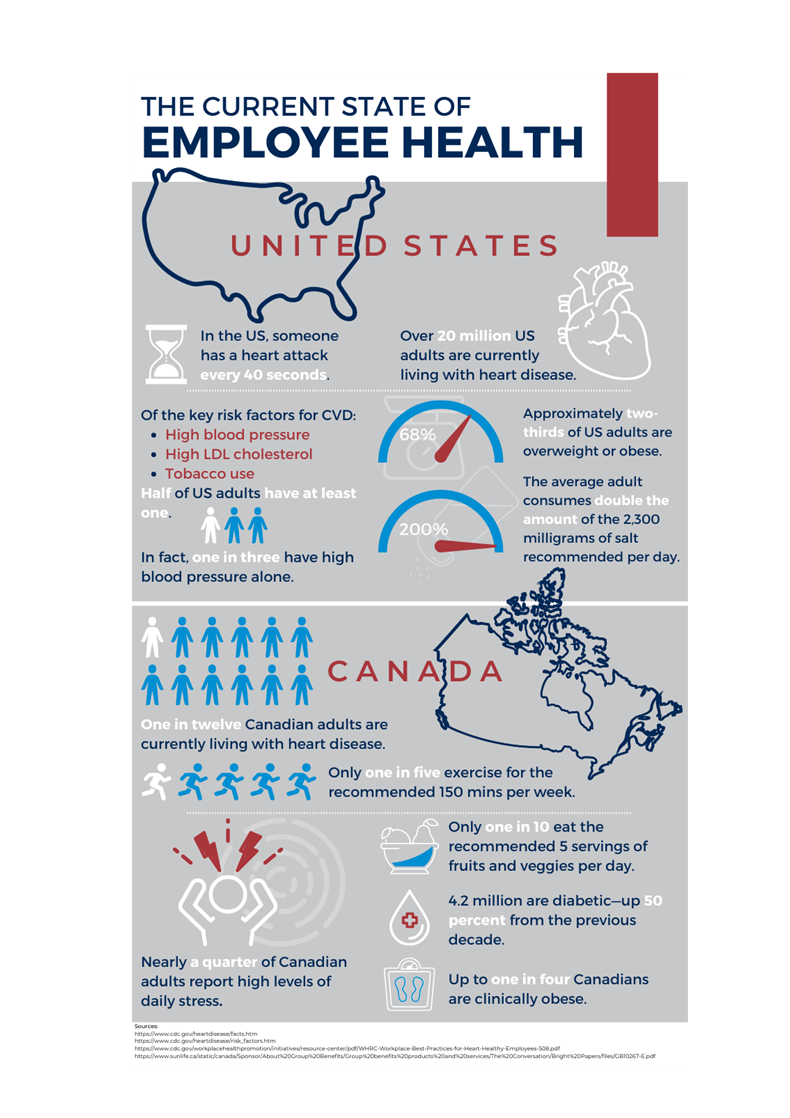Incentives to Keep Employees Heart Healthy at Work
For more than a century now, heart disease, or cardiovascular disease (CVD) has been the leading cause of death in the United States and Canada*, accounting for one-fifth to one-half of all deaths each year, respectively.1-2 To put that into perspective, this means that one person dies every 34 seconds in the US or about every four minutes in Canada from CVD.3-4
But despite these alarming statistics, mortality rates from CVD had been steadily on the decline over the past several decades, thanks in large part to breakthroughs in CVD prevention and treatment; in fact, by the end of 2019, it was estimated that death rates from CVD had declined by more than 70 percent since the 1960s. And then came the “Great Destabilizer” known as the COVID-19 pandemic, completely reversing such trends. By the end of 2020, the death rate for CVD increased by more than four percent, erasing nearly five years-worth of progress made in the previous decade—when the death rate fell by nearly 10 percent—in just a single year.5
Of course, some of this is likely due to COVID itself, as emerging research continuously evinces a link between prior infection and an increased risk of cardiovascular events including heart attack or stroke, while even mild cases are shown to increase a person’s risk of CVD for at least a year after diagnosis.6
Another important factor to take into account when considering these statistics is that, despite the steady decrease in mortality rates over the years, rates of CVD have continued to increase—even prior to the pandemic. According to a study published in August 2022, CVD risk factors including diabetes, hypertension, obesity, and CVDs including stroke, heart failure, and ischemic heart disease, will each have increased by about 30 percent by 2060, as CVD becomes a more survivable, but nevertheless uncurable, chronic condition.7
So with such risk factors and cases of CVD continuing to rise, perhaps the COVID-19 pandemic was simply the catalyst needed to worsen the disease and trigger a cardiac event.
But then, one must consider the wide-ranging impact that the pandemic has had on virtually every aspect of people’s lives: more than triple the number of people in the US and Canada are now working remotely, and with that, average daily step counts have more than halved; drug and alcohol (substance) use has skyrocketed, as have unhealthy eating habits like midnight snacking, emotional or binge eating, or eating foods high in fat, sodium, and sugar; and as a result of these sudden changes and loss of healthy coping skills or routines, people are now dealing with higher levels of stress in addition to unintentional or unwanted weight changes or other changes to their mental health or physique—all of which can have a detrimental impact on the heart.8-13
Given this, it’s no surprise, then, that both prevalence and mortality rates of CVD are continuing to rise, even as treatment for such diseases continues to improve. But just as such behavioral or lifestyle changes pose considerable risk for illness and death, the reverse—that they can serve as protective factors against them—is also true. In fact, according to the WHO, 80 percent of premature cardiovascular-related events are preventable—especially through the adoption healthy lifestyle habits such as eating a well-balanced diet, getting regular physical activity, and limiting use of alcohol, tobacco, and other substances.14
Considering that a third of the average person’s life is spent at work, the workplace therefore plays an integral part in preventing CVD and protecting employees’ heart health; thus making it imperative that workplace operations incorporate healthy, conducive practices that prioritize employee health, safety, and wellness in addition to output or profit.15
That said, the purpose of this toolkit is to offer wellbeing managers ideas on how they can incentivize employees to take better care of their heart health in the workplace, including real-life examples of some initiatives in action, sample materials for them to use or model their own from, and how they can cultivate a healthy workplace environment in which employees are empowered not only to work at their best, but feel their best, too.




































